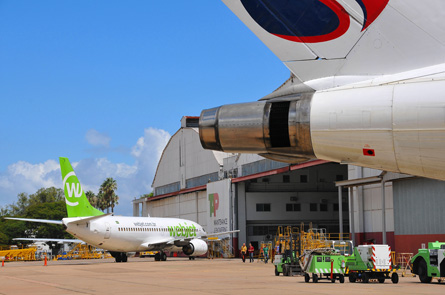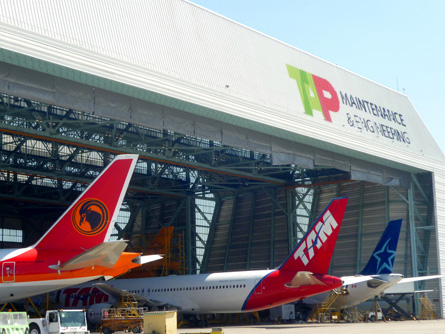When former Brazilian flag carrier Varig went into administration in 2005, its Portuguese counterpart, TAP, spotted an opportunity to expand across the Atlantic - but by maintaining other airlines' aircraft rather than flying its own.
TAP snapped up one of Varig's prize assets - its maintenance, repair and overhaul unit - and set about transforming it from an in-house division that was sourcing 85% of its sales from its parent airline, into Latin America's largest MRO, with an almost 100% third-party customer base.
Boasting an annual capacity of 1.6 million hours, the MRO - run as part of TAP's Lisbon-based Maintenance & Repair division - is the seventh-largest in the world, says chief executive Nestor Koch.
Its 242,000m2 (2.6 million ft2) of infrastructure is more extensive than the operations in Portugal. TAP M&E Brazil's hangar in Rio de Janeiro - the biggest in Latin America - can house four twin-aisle aircraft, and a second facility at Porto Alegre has room for one widebody and four narrowbodies. In addition, there are around 20 workshops and laboratories for electrical calibration and chemical and metallographic analysis.
SWITCHING FOCUS
Koch is proud of the speed at which the unit has switched its focus, building expertise in the last few years in Airbus and Embraer as well as Boeing aircraft - which had made up the bulk of Varig's fleet. Around 60% of the MRO's revenues come from airframes, with Airbus making up about half of that, Embraer a third and Boeing the remainder.
"It's completely different to eight years ago," he says. Component MRO makes up a further 30% of the business, where its approvals include with Boeing to repair and overhaul 777 landing gear axles. With no anchor airline, it exited the line-maintenance market in 2008.
With only 2% of its revenues coming from TAP airline itself, TAP M&E Brazil has built itself a global customer base. Domestic airlines - including rivals Gol and TAM - account for less than half of its business, while the rest of Latin America makes up around 15%, says Koch.
North America is a key target market, with several charter airlines taking advantage of the division's competitive rates and capacity to maintain several aircraft at once during the winter season. "We have invested heavily in our brand, convincing US and Canadian airlines to come here because we are cheaper," says Koch.
 |
|---|
| TAP TAP M&E's facility in Porto Alegre |
SKILLED WORKFORCE
However, the MRO's image is not all about low cost. TAP M&E Brazil's 85 years of heritage - Varig began flying and fixing its aircraft in 1927 - has created a "very skilled workforce", to which "European expertise" has been added in recent years, says Koch.
However, keeping competitive is an ongoing battle. Brazil's breakneck economic growth is causing inflationary wage pressures and driving up the value of the currency against the dollar.
"We try to keep our prices down but every year we need to be 6-7% more competitive than the last," says Koch. "If we are charging $50, next year that needs to be $53, but the market will be charging $47."
That means Koch and his management team have constantly had to innovate when it comes to lean processes and efficiencies. "It's all about reducing the man hours you need to take when you receive the plane," he says. "We need to be better each year. If not, we lose the international market."
He remains bullish though. "We want to grow our share of the international market by 6-7% over the next three years, and domestic MRO is growing a lot too," says Koch.
Other possible growth areas could be business jets and helicopters - two rapidly expanding sectors in Brazil and the rest of Latin America - although the company would only consider component MRO, not airframes, he says.
Another is the military market. TAP M&E has been providing services to the Brazilian armed forces, as well as other Latin American nations, since the 1970s, although this has been less of a focus for the business in recent years.
 |
|---|
| TAP TAP's Rio hangar is largest in the region |
ROLLS-ROYCE'S 53 YEARS OF LOCAL HERITAGE
Rolls-Royce is one of the oldest foreign aerospace investors in Brazil - its facility in Sao Paulo opened in 1959, one of five service centres globally wholly owned by the UK engine maker (another eight are joint ventures) and the only one in Latin America.
As well as the region's airlines and general aviation operators, the Brazilian military has been a major customer over the years, with Rolls-Royce engines currently powering its Lockheed Martin C-130Hs and P-3 Orions, as well as AgustaWestland Lynx helicopters.
The site, which employs almost 300 people, focuses on repairing and overhauling mostly legacy Rolls-Royce types - the AE 3007, Avon, Gem, M250, Tay and T56. However, the region's recent spate of airline orders for Trent XWB-powered Airbus A350s and Trent 1000-powered Boeing 787s holds out the possibility of the facility at some point moving into the highly lucrative Trent overhaul market. At the moment, Sao Paulo carries out "hospital work" on the Airbus A330's Trent 700. "We continue to assess our network of overhaul capability", but moving seriously into the Trent segment would require "multi, multi tens of millions of dollars" of investment, says Peter Turner, vice president customers civil aerospace.
For Rolls-Royce, "things are going very well in Latin America", says Turner. "GDP is predicted to continue growing strongly, not just in Brazil, but also in Chile and Colombia. Industry drives business travel and prosperity drives leisure travel. It's very rosy."
Recent customers in the region have included Avianca Taca and LAN, which have ordered 787s, and TAM and Synergy Aerospace for the A350. "When you add it all up, it's 81 firm aircraft orders," says Turner.
Source: Flight International
















